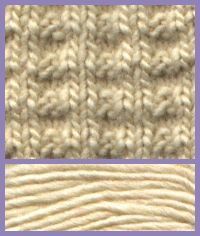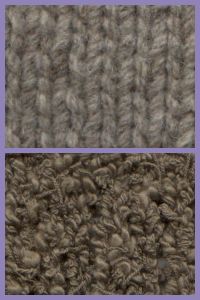...a field guide to yarn substitutions
If a pattern specifies a particular
yarn, then that's the yarn you have to use, right?
Of course not.
There are several reasons why
you might choose to use a different yarn. Perhaps
the specified yarn is now discontinued. Maybe
the cost of the specified yarn is beyond your
means, or in a fit of financial restraint, you've
decided to dive into your stash for a replacement
yarn.
Some knitters don't think twice
about swapping out the pattern's choice of yarn
for their own. But others get downright nervous
at the thought of deviating from the written word.
For those of you who might fall into this second
group, this article is for you. As you'll read
below, making a judicious substitute yarn selection
is simply a matter of asking yourself three basic
questions.
Question One:
Does my yarn knit to the gauge required by
the pattern?
First, you need to make sure
that you can knit your potential substitute yarn
to the gauge specified in the pattern.
If your pattern provides gauge
information for stockinette stitch, it's easy
to figure out whether your alternative will knit
to the same gauge by comparing the pattern's target
gauge with your yarn's label gauge. Ideally, you'd
confirm the match by knitting and blocking [or
laundering] a gauge swatch.
 |
| Labels aren't laws.
This alpaca/wool yarn has a "label
gauge" of 4.5 stitches per inch - typical
aran weight. But on 2.75 mm needles, it knits
to 7 stitches per inch and still maintains
a soft hand. |
 When
the design incorporates lace, textural stitches,
or colorwork, the pattern instructions may direct
you to knit a gauge swatch in something other
than one-color stockinette, which will affect
the final gauge of the knitted fabric. In that
case, the best way to verify that your yarn will
work is to knit that swatch. Sometimes, it's just
not feasible to knit a gauge swatch before purchasing
a substitute yarn. In that case, you'll have to
rely on a comparison of the stockinette stitch
gauge of the pattern's specified yarn with the
stockinette stitch gauge of your intended replacement.
Although it's not a guarantee, it's often a good
indicator of whether your yarn will knit to the
pattern gauge.
When
the design incorporates lace, textural stitches,
or colorwork, the pattern instructions may direct
you to knit a gauge swatch in something other
than one-color stockinette, which will affect
the final gauge of the knitted fabric. In that
case, the best way to verify that your yarn will
work is to knit that swatch. Sometimes, it's just
not feasible to knit a gauge swatch before purchasing
a substitute yarn. In that case, you'll have to
rely on a comparison of the stockinette stitch
gauge of the pattern's specified yarn with the
stockinette stitch gauge of your intended replacement.
Although it's not a guarantee, it's often a good
indicator of whether your yarn will knit to the
pattern gauge.
So, when you begin your search
for the perfect substitution, you'll probably
start in your local shop or online, looking at
the yarns that are labelled with a gauge that
matches the pattern's specified yarn. But don't
forget, potential substitutes might also be found
in other gauge [weight] categories. By increasing
and decreasing your needle size, you can alter
the gauge and characteristics of the knitted fabric.
Radical changes to the knitted
gauge of your yarn will likely affect the behaviour
of the knitted fabric. And this leads us to the
next question:
Question Two:
Will my yarn behave the way the pattern expects
it to behave? [And if not, is that okay?]
Next, take a little time to
study the pattern design.
Examine the drape of the garment
on the model [if available] to determine how the
knitted fabric should behave. Should it drape
softly? Should it have more body? Do you like
the way it looks? If you use your alternative
yarn, will your knitted fabric do that?
For example, Topsecret
from Knitty's inaugural issue specifies a gauge
of 12 stitches over 4 inches. The two yarns pictured
below knit to the same gauge, but only one of
them would be a suitable alternative to the original
yarn. The wide sleeves and cowl of Topsecret benefit
from a fabric with more flexibility and drape,
which is provided by the pattern's specified yarn.
The bulky cotton bouclé shown below would
provide this needed drape.
 |
| Same gauge, different
results. Belle Vallée 4-ply
rug wool [top], and Adrienne Vittadini Adriana
cotton boucle [bottom] knit to the same number
of stitches and rows per inch, but they behave
differently. The thick wool fabric is stiff
there's little space between the stitches,
so the fabric is less flexible. The cotton
bouclé is bulky too, but the space
between the stitches [obscured by the texture
of the yarn] gives the fabric more drape. |
 Also
examine the stitches and techniques used in the
pattern. Are there twists and cables? They may
be more difficult to work in an inherently inelastic
yarn, such as cotton or linen. Is there knit and
purl-textured patterning? It might be hidden by
a furry or fuzzy yarn.
Also
examine the stitches and techniques used in the
pattern. Are there twists and cables? They may
be more difficult to work in an inherently inelastic
yarn, such as cotton or linen. Is there knit and
purl-textured patterning? It might be hidden by
a furry or fuzzy yarn.
Sometimes, the designer may
have specifically designed a garment to highlight
the features of the specified yarn. The construction
of Rosedale
and Tilt,
for example, turn the long color gradations in
Noro yarns to advantage. In a yarn without those
slow, progressive color shifts, the clever engineering
of these garments is less apparent.
If you already knit a gauge
swatch in pattern, you probably noticed any shortcomings
in your substitute yarn choice. If you haven't
swatched, keep these considerations in mind when
selecting your replacement yarn.
Question Three:
How much yarn will I need?
Now, it's time to engage in
some simple arithmetic.
Once you've identified a suitable
alternative yarn, you just need to make sure you've
got the same length - not weight - of yarn indicated
in the pattern requirements. Length is a more
accurate measure than weight because different
yarns have different densities. A cotton and a
wool yarn may knit to the same gauge, but you'd
find that a ball of the cotton yarn will have
less yardage than a similarly sized ball of wool.
From the pattern's yarn requirements,
multiply the number of skeins, balls, or spools
with the yardage of a single unit. For example,
if the pattern calls for 13 skeins of yarn with
a yardage of 121 yards, then you'll need a total
of 13 x 121 = 1573 yards in your substitute yarn.
Make similar calculations with your substitute
yarn to make sure that you have enough.
Sometimes patterns omit the
yardage information. In that case, you'll have
to look up the yarn's vital statistics using one
of the suggested resources below.
Substitutions, in summary
To précis the search
strategy discussed in this article, it boils down
to three simple steps:

Follow these steps, and you'll
be making confident yarn substitution decisions.
Online searching for gauge and
yardage information of current yarns: try an Internet
search engine such as Google,
or visit an online yarn shop and browse through
their selection.
More information on gauge and
weight categories: consult the Craft Yarn Council
of America's new standards
table [not all publishers or vendors follow
this table, but it provides useful guidance].
Online information about
discontinued and/or "vintage" yarns:
wiseNeedle
is a free database of current and discontinued
knitting yarns, including yardage and gauge information
and user-submitted reviews.
Vintage
Knits has tables listing the yardage and fiber
content of discontinued yarns, categorized by
gauge.
Offline information
about current and discontinued yarns:
Valuable Yarn Information is a cerlox-bound
book with yardage and gauge information for 13,000+
yarns, updated twice yearly and available for
sale from knitting shops.
Knit Wise®Yarn Finder covers 3,000
yarns and is available on CD-ROM or in print.
Long out of print, Maggie Righetti's Universal
Yarn Finder [Prentice Hall, 1987] provides
information about fiber composition, gauge and
yardage of older yarns.

